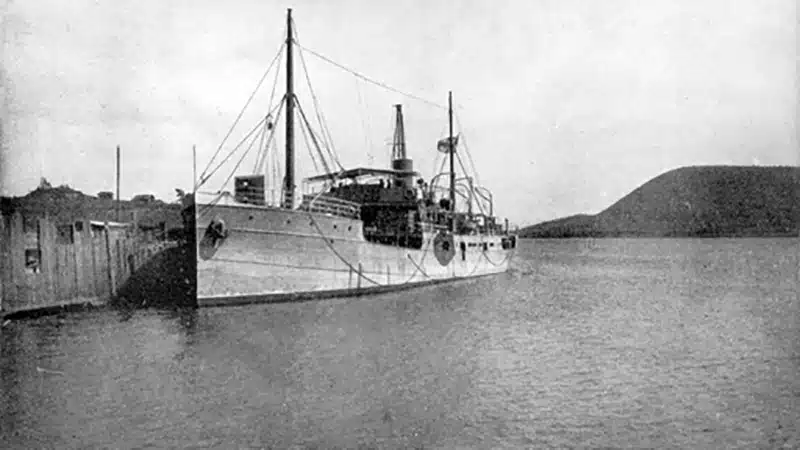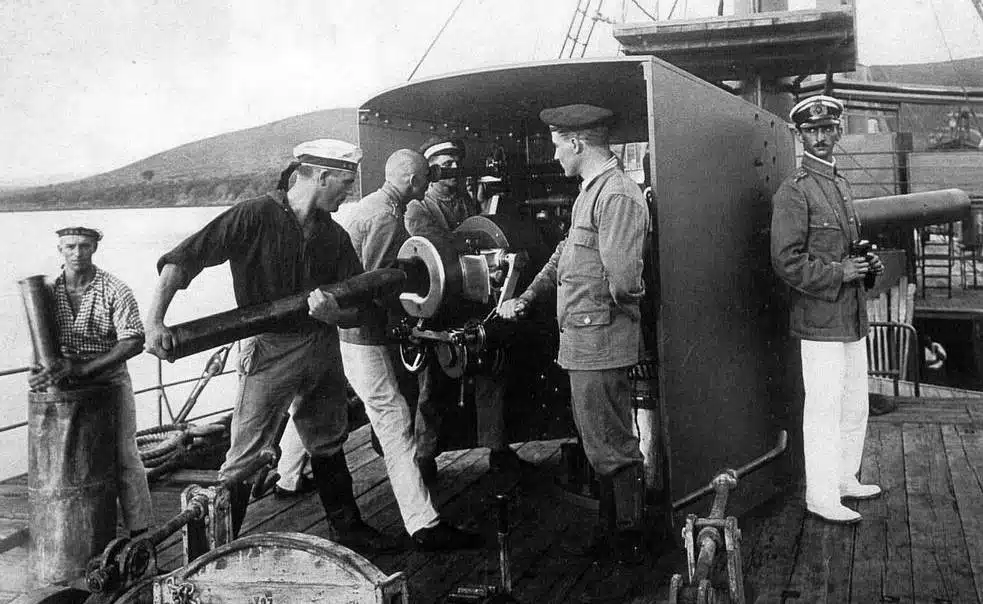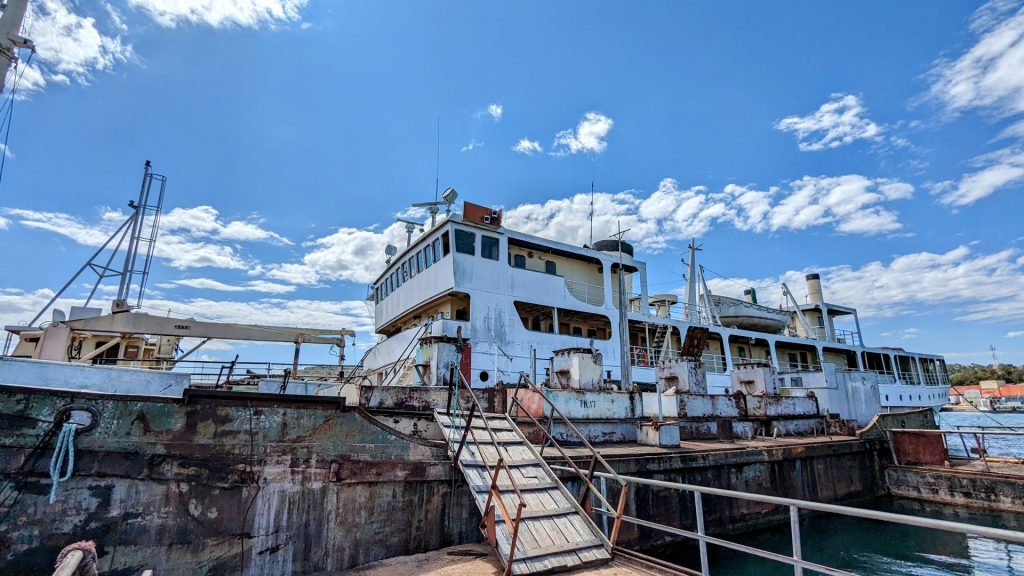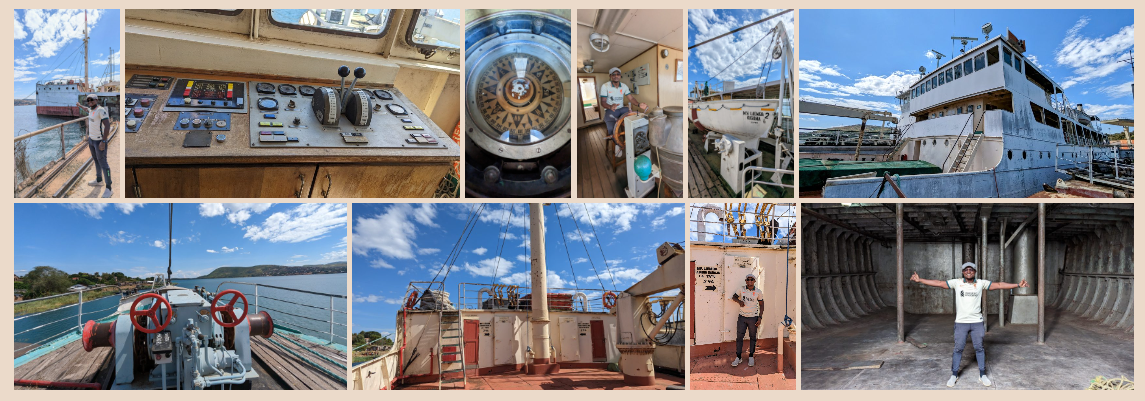Stepping onto MV Liemba is like stepping back in time. With its rich history and timeless allure, this legendary ferry has been integral to Tanzania’s maritime heritage for over a century. Traversing the sparkling waters of Lake Tanganyika, MV Liemba holds captivating tales of adventure, making it a must-visit attraction for history enthusiasts and adventurous travellers alike.
MV Liemba was built in 1913 at the Meyer Werft shipyard in Papenburg, Germany. It was initially named SS Graf von Goetzen after Count Gustav Adolf von Gotzen, the German East African governor from 1901 to 1906. After its construction, the SS Graf von Goetzen was ten dismantled and transported to Tanganyika in 5,000 crates, where it was later reassembled in Kigoma, on the shore of Lake Tanganyika, and launched in 1915.

World War I
During World War I, the lake became a crucial battleground between German and British forces, and MV Liemba, known as Graf von Goetzen at the time, played a pivotal role in the conflict where she transported soldiers, equipment, and supplies, providing support to German forces stationed around the lake.
During the war, the bombing strikes did not substantially damage the Goetzen, but she stayed in the harbour. In early May, the Germans had already withdrawn the majority of her guns because they required them somewhere else. Goetzen had just one 37-millimeter Hotchkiss left during the air strike, which she utilized like an anti-aircraft cannon.
By this point, the war on the lake had stopped, with both sides refusing to launch attacks. On the other hand, the fight on land was developing, mainly for the Allies’ benefit, who broke off the railway connection in July 1916, isolating Kigoma.
However, the same year, as the Germans were losing to the British and Belgian forces and retreating from Kigoma, Gustav Zimmer, the German naval officer on the lake, quit the town and travel south. General Lettow-Vorbeck commanded the scuttling of the Goetzen to prevent her from coming into Allied hands.
The task was handed to three Meyer Werft engineers who had travelled to Lake Tanganyika with the disassembled parts of the ship to supervise its re-assembly. The engineers resolved on their own to try to facilitate a subsequent salvage; they filled the boat with sand and greased all of the engines before carefully capsizing her on July 26 at a depth of 66 feet (20m) near the shores of Katabe Bay (Bangwe Bay according British designation; and Baie de l’éléphant according to Belgian appointment) at the position 29°36′12′′East 4°54′5′′South.
Salvage and Recommissioning
In 1918, a Swedish working for Belgium, J. Ludwig Wall, rescued the ship. He had enormous amounts of stuff removed by divers at first. Then he loaded empty barrels into the holds and ran cables beneath the ship to two 375-ton barges that they had been custom-built for the job by “Compagnie des Chemins de fer du Congo Supérieur aux Grands Lacs Africains” and placed on either side of the disaster.
The Belgians had raised the ship to her gunwales by wrapping it in the cables by the end of June 1919. The Belgians then floated the partially immersed warship to Kigoma in mid-September. She sank to the bottom in water 20–23 feet (6–7m). Her superstructure stretched above the lake’s surface since the water was shallow.
A storm pushed the ship early in 1920, sinking her at Point Lusana in 29°37′21′′East 4°52′15′′South. The ship was not visible in the images of H. L. Shantz in Kigoma Bay in February 1920.
Post-war, the British Royal Navy raised the ship in 1924. Because it was well-greased, the British found the boat usable and renovated it. While preparing to work on it, the ship sank again (positioning and slope) and had to be raised again.
In 1927, the ship’s restoration was completed, and it was officially renamed Liemba, a local name for the lake at the time. It has been in service ever since.
MV Liemba From 1927 to 1948
Following Lord Baden-Powell’s death on January 7, 1941, Olave, Lady Baden-Powell, his widow, sailed from North of Rhodesia to the north in the MV Liemba.
Between 1948-1952 and Since 1952
After a two-year hiatus, MV Liemba returned to service in 1952.
Since 1927, MV Liemba has been running practically nonstop. The ferry was taken over by EAR&H (East African Railways and Harbours Corporation) in 1948, allowing it to connect with the Central Line from Kigoma to Dar es Salaam. The ship was renovated from 1976 to 1979.
Twin diesel engines replaced the original steam engines at this time. Patrick “Paddy” Dougherty was the main force behind the remodelling. He was born in Downpatrick on March 18, 1918, and worked as an apprentice at Harland & Wolff in Belfast. Following that, he joined the Royal Navy and worked as a ship’s engineer throughout WWII.
He worked for the EAR&H, Kisumu, Kenya, as a first engineer, then as chief engineer on Lake Victoria ferries in the 1960s and 1970s. He left Tanzania after completing the reconstruction of MV Liemba.
The EAR&H was disbanded in 1977, and MV Liemba was taken over by the TRC (Tanzania Railways Corporation). The corporation overhauled MV Liemba in 1993 with the help of Denmark’s shipyard OSK ShipTech A/S and the International Development Agency of Denmark.
The deckhouse, pipes, and the electronic system were all rebuilt, as were the crew and passenger cabins, new MAN engines with 620 horsepower (460 kW) apiece, a hydraulic hoist on the foredeck, and the transformation of the rear freight hull into a passenger cabin (with a capacity increase to 600 commuters). MV Liemba acquired a double floor in the forward baggage compartment to promote security. The boat was re-measured, and the

Danish technicians discovered that MV Liemba was 234 feet 3 inches (71.40 meters) long with a 10m beam (32 feet 10 inches). The ship’s upgraded machinery allows it to reach a top speed of 20 km/h, 13 mph (11 knots.)
MV Liemba presently features ten first-class passenger rooms (double bed) and 2 VIP rooms. Eight second-class cabins are also available (6 double and 12 quad-beds).
TRC’s inland transport branch, the Marine Services Co. Ltd, was spun off in 1997.
Following the collapse of longstanding ruler Mobutu Sese Seko in 1997, the UN’s High Comm. for Refugees utilized the Motor Vessel Mwongozo and MV Liemba to rescue over 75,000 refugees who’d already left Zaire during Congo War 1. MV Liemba conducted 22 visits between Uvira and Kigoma during the 5-month operation. The UN engaged her in May 2015 to rescue 50,000 people escaping Burundi’s civil war.
The BBC aired 2014 a documentary about the ship as part of their “WW1-Beyond the Trenches” series.
Renovation or Replacement of MV Liemba
TRC requested assistance from the German government in upgrading or replacing the ship in a letter sent in 2011. The German government conducted research showing that building a new vessel would be less expensive than rehabilitating MV Liemba. The final appeal for financial assistance came from the governments of Lower Saxony, where the ship was built, and Berlin, with then-German President C. Wulff noted that the boat had a “unique history” and provided “indispensable service” to the inhabitants of East Africa.
In 2017, the MV Liemba was in Kigoma for substantial maintenance. Since August 9, 2018, it has been sailing again.
MV Liemba’s captivating story caught the attention of author C.S. Forester, who immortalized her in his novel “The African Queen.” Although the book’s story was set on a different lake, the novel’s success brought global recognition to the legendary ferry. Later, in 1951, the novel was adapted into a movie starring Humprey Bogart and Katharine Hepburn. While the film was shot elsewhere, the essence of MV Liemba’s adventure and mystique lived through the silver screen.
Interesting Facts About MV Liemba
- MV Liemba is the oldest “operating” passenger ship in the world. It’s been sailing between Kigoma, Tanzania and Mpulungu, Zambia, since 1915.
- It is also the only ship of the German Imperial Navy still actively in operation.
- The vessel can carry a total of 200 tonnes and 600 passengers.
Getting to MV Liemba
MV Liemba is currently found in Kigoma, and travelling to see it is an adventure. From Dar es Salaam, the Journey to Kigoma, the main port on Lake Tanganyika, can be made via several modes of transportation.
Flight: The quickest and most convenient option is a domestic flight from Dar es Salaam to Kigoma. The flight takes approximately two hours, offering stunning aerial views of Tanzania’s landscapes.
Train: For travellers seeking a more immersive experience, the central route train connects Dar es Salaam to Kigoma. The train journey takes two to three days, passing through picturesque landscapes and offering a glimpse of rural life.
Road: An alternative option is to embark on a road trip from Dar es Salaam to Kigoma. The Journey takes approximately 20-24 hours, depending on road conditions and stops along the way.
Find more historical details here.




Quite an incredible story. I hope it retires soon as it has served for over 100 years already.